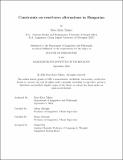Constraints on vowel-zero alternations in Hungarian
Author(s)
Takács, Dóra Kata
DownloadThesis PDF (1.733Mb)
Advisor
Albright, Adam
Steriade, Donca
Terms of use
Metadata
Show full item recordAbstract
I analyze a large set of Hungarian nominal stems whose last vowel alternates with zero in certain contexts (Vago (1980), Siptár & Törkenczy (2000)): e.g. bokor [bokor], bokr-ok [bokr-ok]. I argue that the mechanism underlying these alternations is syncope, departing in this from earlier work (Vago (1980), Abondolo (1988), J. Jensen & Stong-Jensen (1988, 1989), Törkenczy (1995), Abrusán (2005)) which assumes epenthesis or metathesis. My research focuses on which stems fall into this closed group of vowel-zero alternating stems. I show that there is an interaction between phonological processes that repair phonotactically illicit consonant clusters – like voicing assimilation, gemination, affrication – and vowel-zero alternations. I present a proposal relying on underspecification that correctly predicts that these phonological processes block vowel-zero alternations. The grammar that generates this result includes a ranking schema where the constraint triggering syncope (referred to below as Syncope) is outranked not only by the Markedness constraints that define illicit CC-clusters in Hungarian but also by the faithfulness constraints that are normally violated in the repair of such clusters. The general ranking I will argue for is: (1) Markedness (*CC for various CCs) » Faithfulness to Cs » Syncope » Max V I also present results from a nonce word experiment, which confirms that Hungarian speakers are aware of the systematic restrictions my analysis characterizes. The broad significance of the work is to document a large-scale conspiracy (Kisseberth (1970)) whereby permissible CC clusters emerge in at least two ways: through direct action of repair processes (assimilation or merger of two Cs into one) and through blockage of the syncope process that could yield the inputs to such repairs.
Date issued
2024-09Department
Massachusetts Institute of Technology. Department of Linguistics and PhilosophyPublisher
Massachusetts Institute of Technology